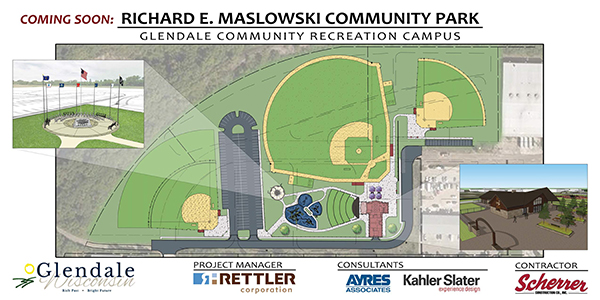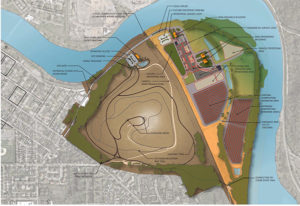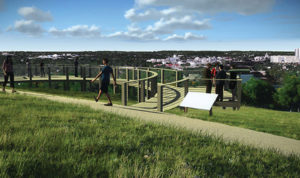Closed Landfills: Managing Limitations, Seeing Possibilities
 You may have read in our last post about the surprisingly long list of facilities that can be built on top of a closed landfill. Whether it’s exercise facilities for athletes or their faithful canine companions, outdoor event sites, or trails to enjoy nature, closed landfills are being turned into useful places that no one would have imagined a half-century ago. Like a phoenix from the ashes, these types of facilities bring new life to a seemingly unusable and blighted site.
You may have read in our last post about the surprisingly long list of facilities that can be built on top of a closed landfill. Whether it’s exercise facilities for athletes or their faithful canine companions, outdoor event sites, or trails to enjoy nature, closed landfills are being turned into useful places that no one would have imagined a half-century ago. Like a phoenix from the ashes, these types of facilities bring new life to a seemingly unusable and blighted site.
As we help communities move from ideas to feasible design concepts, we’re always working to make those ideas work within the client’s needs. We also work to ensure that planned facilities preserve the functionality of the landfill infrastructure and the environmental stability of the site. That includes accommodations for gas vents and wells, monitoring wells, and the all-important clay cap that confines the waste.
Here are some of the factors and how a design can accommodate them:
Here a Vent, There a Vent
Fitting a sprawling sports field in between landfill gas vents and gas wells can be a challenge, especially if a landfill is “passively” vented, where wells stick up across the site. These types of systems can be modified economically by rerouting the vent piping outside the desired activity area. This is the case for the recreational facility that Ayres Associates, working together with Rettler Corporation, is helping to make a reality at the West Bender Road Landfill in Glendale, Wisconsin.
Piping extensions and vent relocations are planned to allow construction of a community center building, amphitheater, playground, parking lot, and municipal roadway with utilities. Future phases of construction will include baseball and softball fields. The designs include rerouting of the passive gas piping so there are no obstacles in the field of play, and they allow for foundations to be built within the limits of waste. Ayres has provided the solid waste engineering that supports the Rettler recreational facility design. Together we have been able to gain regulatory approval for the first three phases of construction at the site for the City of Glendale.
Sites that have “active gas systems” use high-powered vacuum blowers and a flare to burn off landfill gases. These systems can also be modified to remove above-grade obstacles by constructing a subsurface vault and modifying the wellhead. These type of systems are more common in recently closed landfills, where engineers usually can achieve a higher degree of accuracy when assessing the existing conditions at the landfill.

The Right Fit
A landfill’s shape can dictate appropriate uses too. Those that are constructed in the form of a large hill would be nearly impossible to use as a soccer park, as the amount of fill needed to create a plateau above the highest point of the clay cap would be prohibitively expensive. Prairie plantings, parks, walking paths, and mountain biking trails might be more appropriate uses for such a landfill.
Hitting the Weight Limit
Another limitation is the sponge-like nature of the waste that underlies any closed landfill site. This material will never be as stable as other types of natural fill, so building structures on top of landfills is a challenge. Proper geotechnical investigation, appropriate footing design, and subgrade compaction are all important considerations to allow for construction.
No Buried Water Pipes
At least in the case of Wisconsin landfills, drinking water piping cannot be buried within a landfill’s waste, so the most practical option for locating such facilities is just outside the limits of the waste. Plans for the Glendale project include a community building that is just beyond the waste perimeter.
Parking NOT Prohibited
Parking lots are actually good structures to place atop a landfill as long as care is taken to provide a stable, well-compacted subbase to minimize uneven settling. Pavement on top of the landfill further protects the site from seepage of water into the waste. Seepage prevention is a primary goal of the landfill cap.
Not A Good Place for Tap Roots
Also tricky is the need to protect the landfill cap from damage caused by roots. While it would be possible to place a protective plastic layer above the clay cap and below tree plantings, our designers commonly restrict plantings to relatively small, native, shallow-rooting species.
Natural Wildlife Magnets
Landfills are natural sanctuaries for wildlife. Depending on the types of plants growing there, you will see deer, songbirds, butterflies, groundhogs, and countless other creatures, making closed landfills great places to build hiking, biking, and interpretive trails.

The Cedar Rapids Closed Landfill Master Site Plan that Ayres provided for the City soon will lead to the construction of trails and scenic overlooks of the downtown area from atop the closed landfill. You can read more here about how the plans call for nice views, places to exercise, and spots for families to gather.

Post a comment: